HSN719 Assignment 2: Physical Activity and Nutrition Assessment Report
VerifiedAdded on 2023/04/21
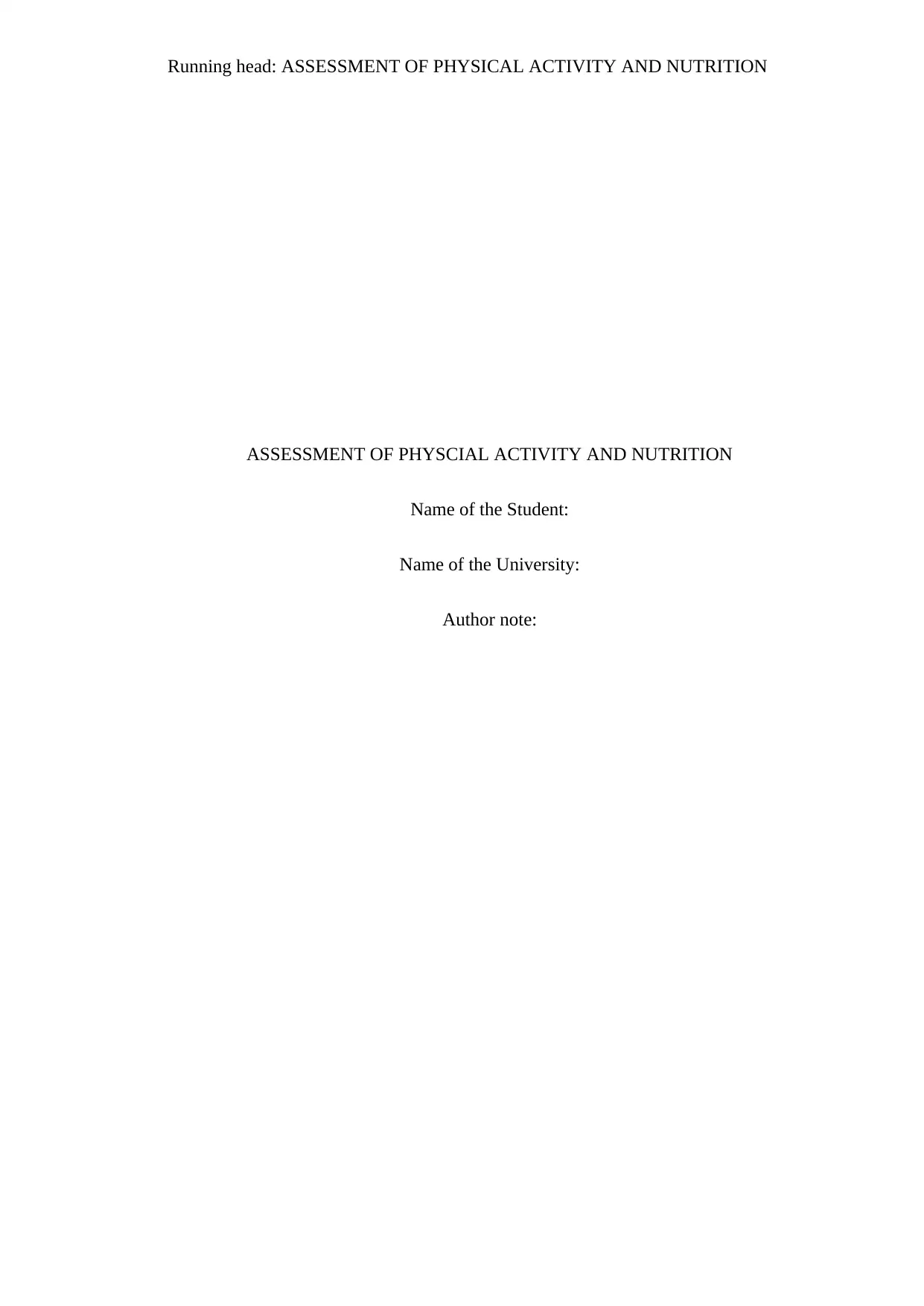
ASSESSMENT OF PHYSCIAL ACTIVITY AND NUTRITION
Name of the Student:
Name of the University:
Author note:
Paraphrase This Document
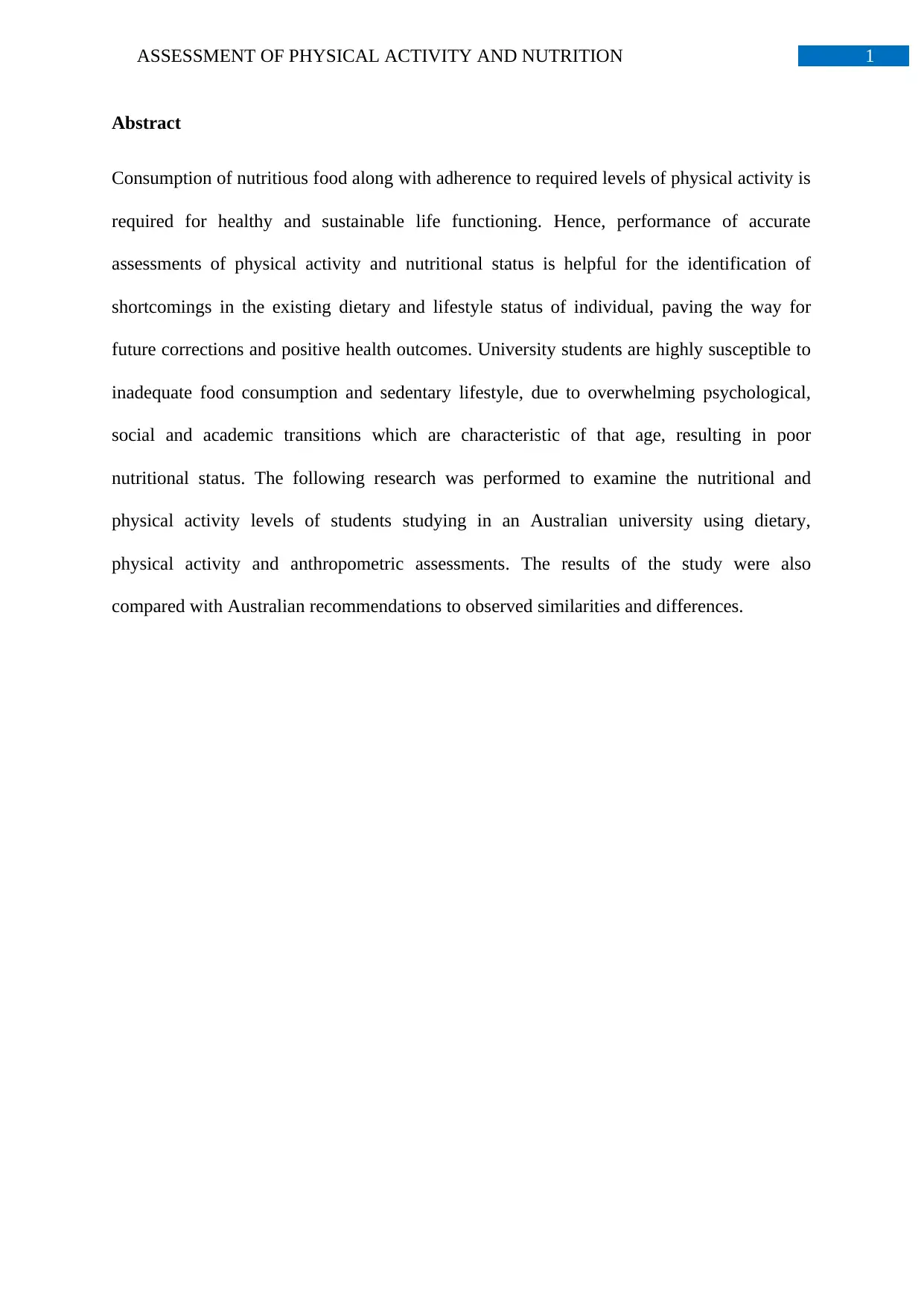
Abstract
Consumption of nutritious food along with adherence to required levels of physical activity is
required for healthy and sustainable life functioning. Hence, performance of accurate
assessments of physical activity and nutritional status is helpful for the identification of
shortcomings in the existing dietary and lifestyle status of individual, paving the way for
future corrections and positive health outcomes. University students are highly susceptible to
inadequate food consumption and sedentary lifestyle, due to overwhelming psychological,
social and academic transitions which are characteristic of that age, resulting in poor
nutritional status. The following research was performed to examine the nutritional and
physical activity levels of students studying in an Australian university using dietary,
physical activity and anthropometric assessments. The results of the study were also
compared with Australian recommendations to observed similarities and differences.
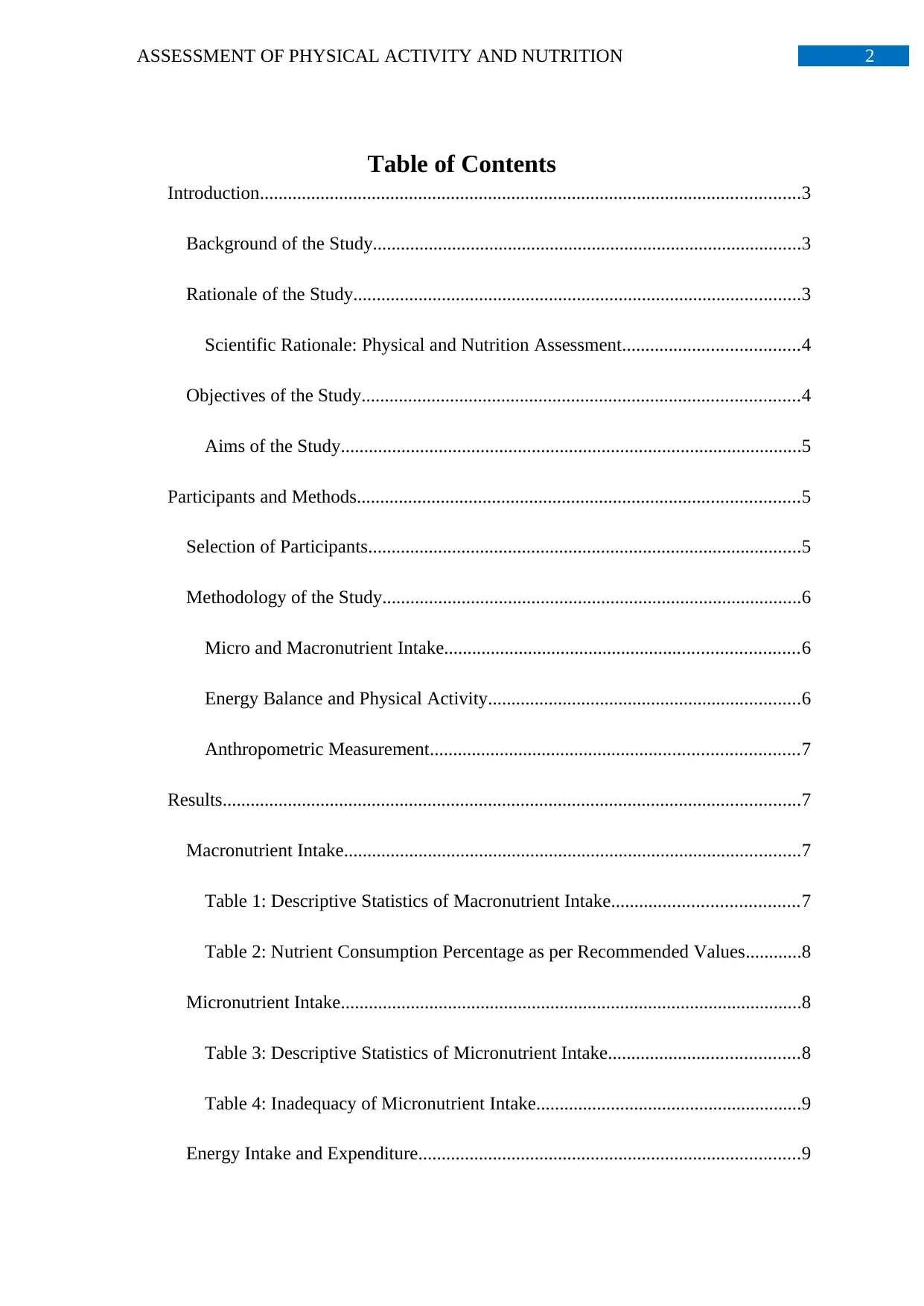
Table of Contents
Introduction....................................................................................................................3
Background of the Study............................................................................................3
Rationale of the Study................................................................................................3
Scientific Rationale: Physical and Nutrition Assessment......................................4
Objectives of the Study..............................................................................................4
Aims of the Study...................................................................................................5
Participants and Methods...............................................................................................5
Selection of Participants.............................................................................................5
Methodology of the Study..........................................................................................6
Micro and Macronutrient Intake............................................................................6
Energy Balance and Physical Activity...................................................................6
Anthropometric Measurement...............................................................................7
Results............................................................................................................................7
Macronutrient Intake..................................................................................................7
Table 1: Descriptive Statistics of Macronutrient Intake........................................7
Table 2: Nutrient Consumption Percentage as per Recommended Values............8
Micronutrient Intake...................................................................................................8
Table 3: Descriptive Statistics of Micronutrient Intake.........................................8
Table 4: Inadequacy of Micronutrient Intake.........................................................9
Energy Intake and Expenditure..................................................................................9
⊘ This is a preview!⊘
Do you want full access?
Subscribe today to unlock all pages.

Trusted by 1+ million students worldwide
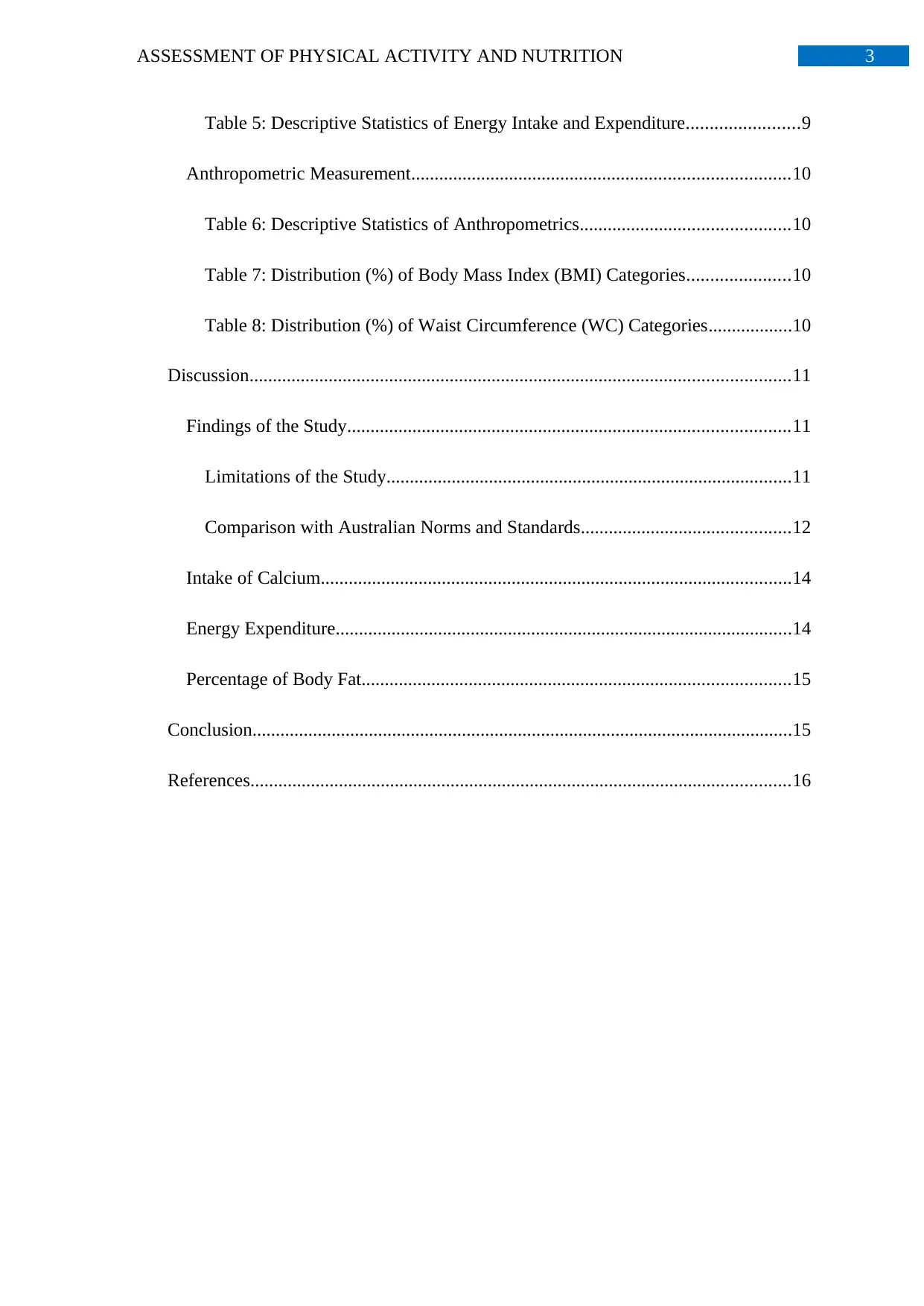
Table 5: Descriptive Statistics of Energy Intake and Expenditure........................9
Anthropometric Measurement.................................................................................10
Table 6: Descriptive Statistics of Anthropometrics.............................................10
Table 7: Distribution (%) of Body Mass Index (BMI) Categories......................10
Table 8: Distribution (%) of Waist Circumference (WC) Categories..................10
Discussion....................................................................................................................11
Findings of the Study...............................................................................................11
Limitations of the Study.......................................................................................11
Comparison with Australian Norms and Standards.............................................12
Intake of Calcium.....................................................................................................14
Energy Expenditure..................................................................................................14
Percentage of Body Fat............................................................................................15
Conclusion....................................................................................................................15
References....................................................................................................................16
Paraphrase This Document
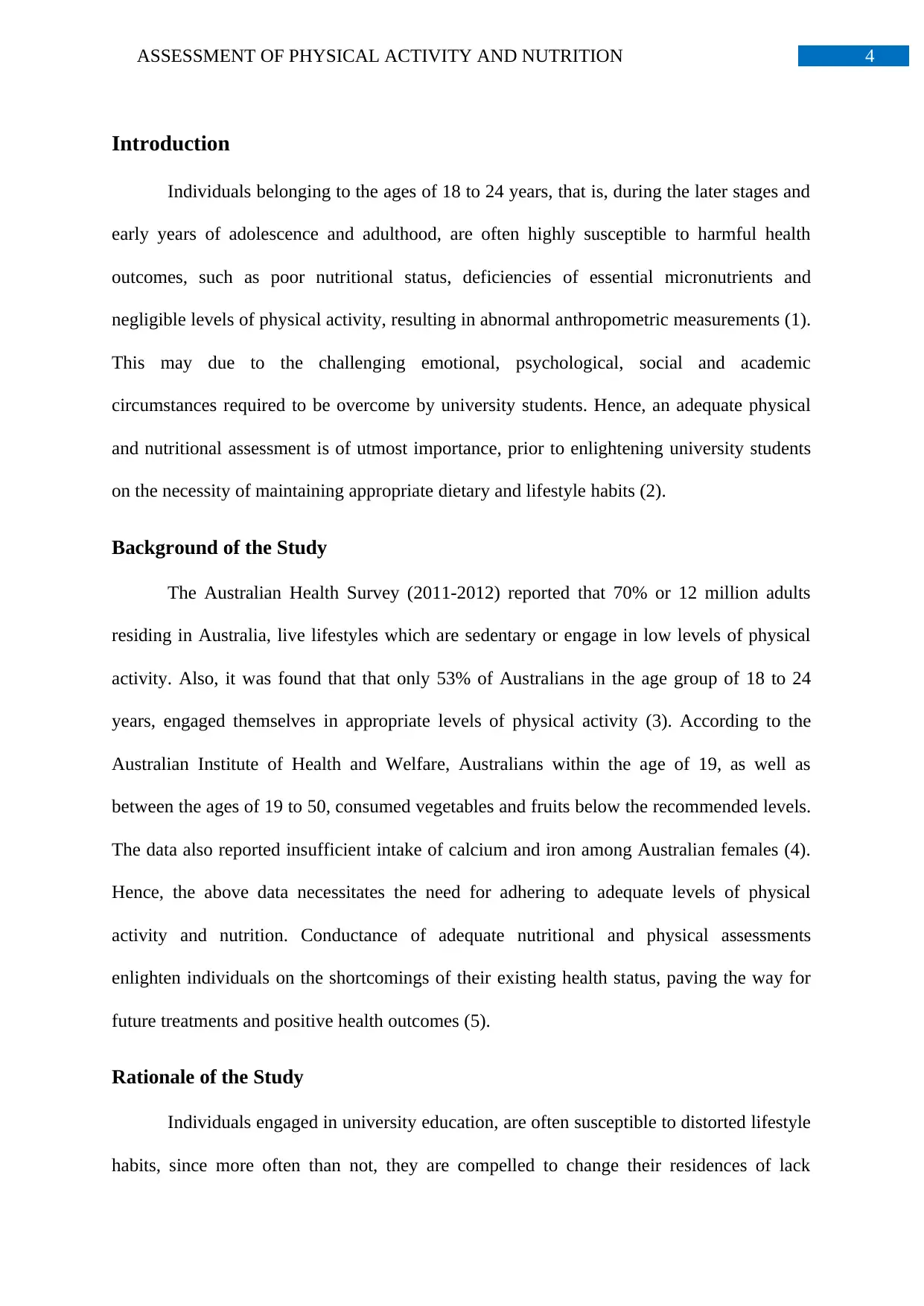
Introduction
Individuals belonging to the ages of 18 to 24 years, that is, during the later stages and
early years of adolescence and adulthood, are often highly susceptible to harmful health
outcomes, such as poor nutritional status, deficiencies of essential micronutrients and
negligible levels of physical activity, resulting in abnormal anthropometric measurements (1).
This may due to the challenging emotional, psychological, social and academic
circumstances required to be overcome by university students. Hence, an adequate physical
and nutritional assessment is of utmost importance, prior to enlightening university students
on the necessity of maintaining appropriate dietary and lifestyle habits (2).
Background of the Study
The Australian Health Survey (2011-2012) reported that 70% or 12 million adults
residing in Australia, live lifestyles which are sedentary or engage in low levels of physical
activity. Also, it was found that that only 53% of Australians in the age group of 18 to 24
years, engaged themselves in appropriate levels of physical activity (3). According to the
Australian Institute of Health and Welfare, Australians within the age of 19, as well as
between the ages of 19 to 50, consumed vegetables and fruits below the recommended levels.
The data also reported insufficient intake of calcium and iron among Australian females (4).
Hence, the above data necessitates the need for adhering to adequate levels of physical
activity and nutrition. Conductance of adequate nutritional and physical assessments
enlighten individuals on the shortcomings of their existing health status, paving the way for
future treatments and positive health outcomes (5).
Rationale of the Study
Individuals engaged in university education, are often susceptible to distorted lifestyle
habits, since more often than not, they are compelled to change their residences of lack
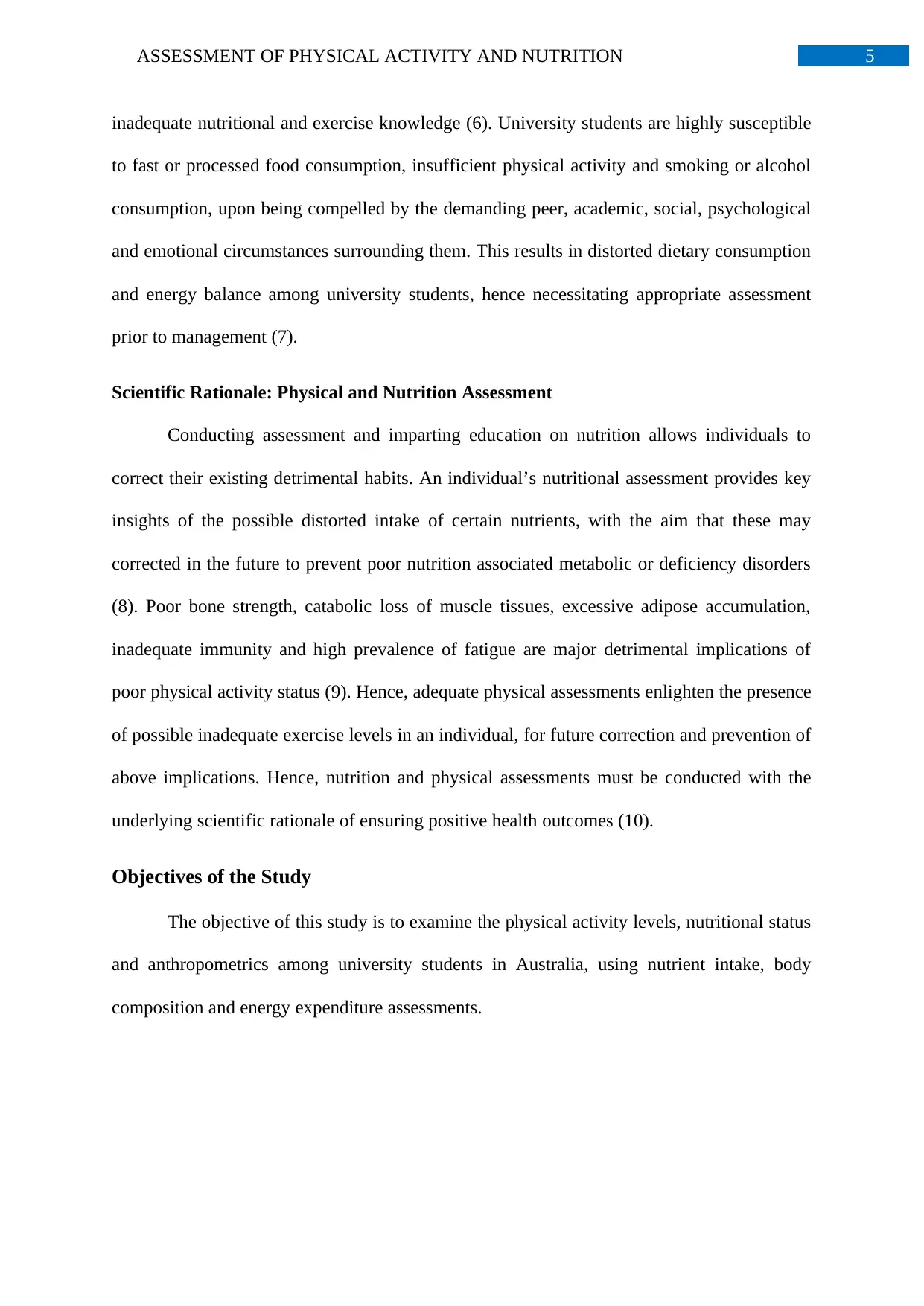
inadequate nutritional and exercise knowledge (6). University students are highly susceptible
to fast or processed food consumption, insufficient physical activity and smoking or alcohol
consumption, upon being compelled by the demanding peer, academic, social, psychological
and emotional circumstances surrounding them. This results in distorted dietary consumption
and energy balance among university students, hence necessitating appropriate assessment
prior to management (7).
Scientific Rationale: Physical and Nutrition Assessment
Conducting assessment and imparting education on nutrition allows individuals to
correct their existing detrimental habits. An individual’s nutritional assessment provides key
insights of the possible distorted intake of certain nutrients, with the aim that these may
corrected in the future to prevent poor nutrition associated metabolic or deficiency disorders
(8). Poor bone strength, catabolic loss of muscle tissues, excessive adipose accumulation,
inadequate immunity and high prevalence of fatigue are major detrimental implications of
poor physical activity status (9). Hence, adequate physical assessments enlighten the presence
of possible inadequate exercise levels in an individual, for future correction and prevention of
above implications. Hence, nutrition and physical assessments must be conducted with the
underlying scientific rationale of ensuring positive health outcomes (10).
Objectives of the Study
The objective of this study is to examine the physical activity levels, nutritional status
and anthropometrics among university students in Australia, using nutrient intake, body
composition and energy expenditure assessments.
⊘ This is a preview!⊘
Do you want full access?
Subscribe today to unlock all pages.

Trusted by 1+ million students worldwide
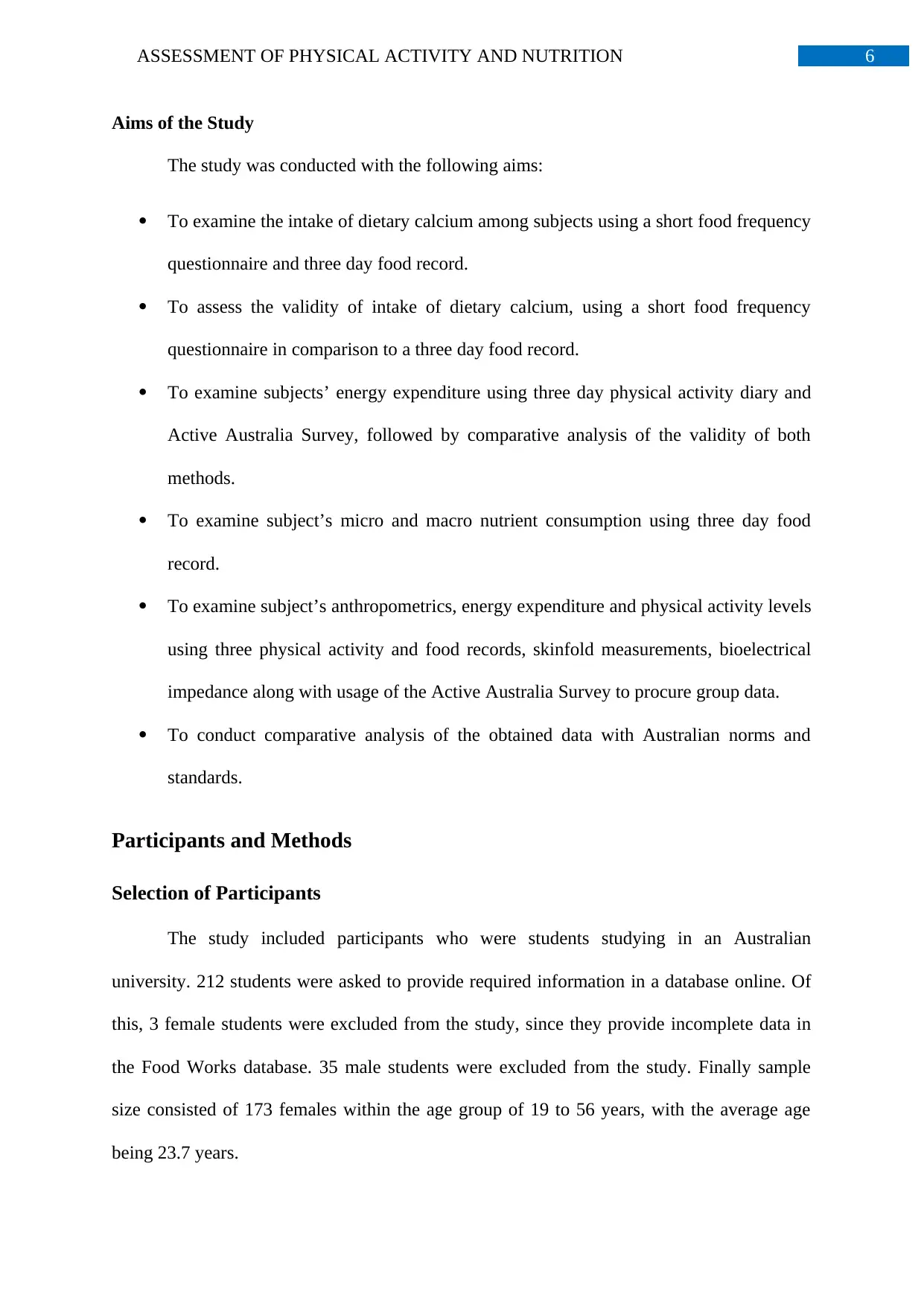
Aims of the Study
The study was conducted with the following aims:
To examine the intake of dietary calcium among subjects using a short food frequency
questionnaire and three day food record.
To assess the validity of intake of dietary calcium, using a short food frequency
questionnaire in comparison to a three day food record.
To examine subjects’ energy expenditure using three day physical activity diary and
Active Australia Survey, followed by comparative analysis of the validity of both
methods.
To examine subject’s micro and macro nutrient consumption using three day food
record.
To examine subject’s anthropometrics, energy expenditure and physical activity levels
using three physical activity and food records, skinfold measurements, bioelectrical
impedance along with usage of the Active Australia Survey to procure group data.
To conduct comparative analysis of the obtained data with Australian norms and
standards.
Participants and Methods
Selection of Participants
The study included participants who were students studying in an Australian
university. 212 students were asked to provide required information in a database online. Of
this, 3 female students were excluded from the study, since they provide incomplete data in
the Food Works database. 35 male students were excluded from the study. Finally sample
size consisted of 173 females within the age group of 19 to 56 years, with the average age
being 23.7 years.
Paraphrase This Document
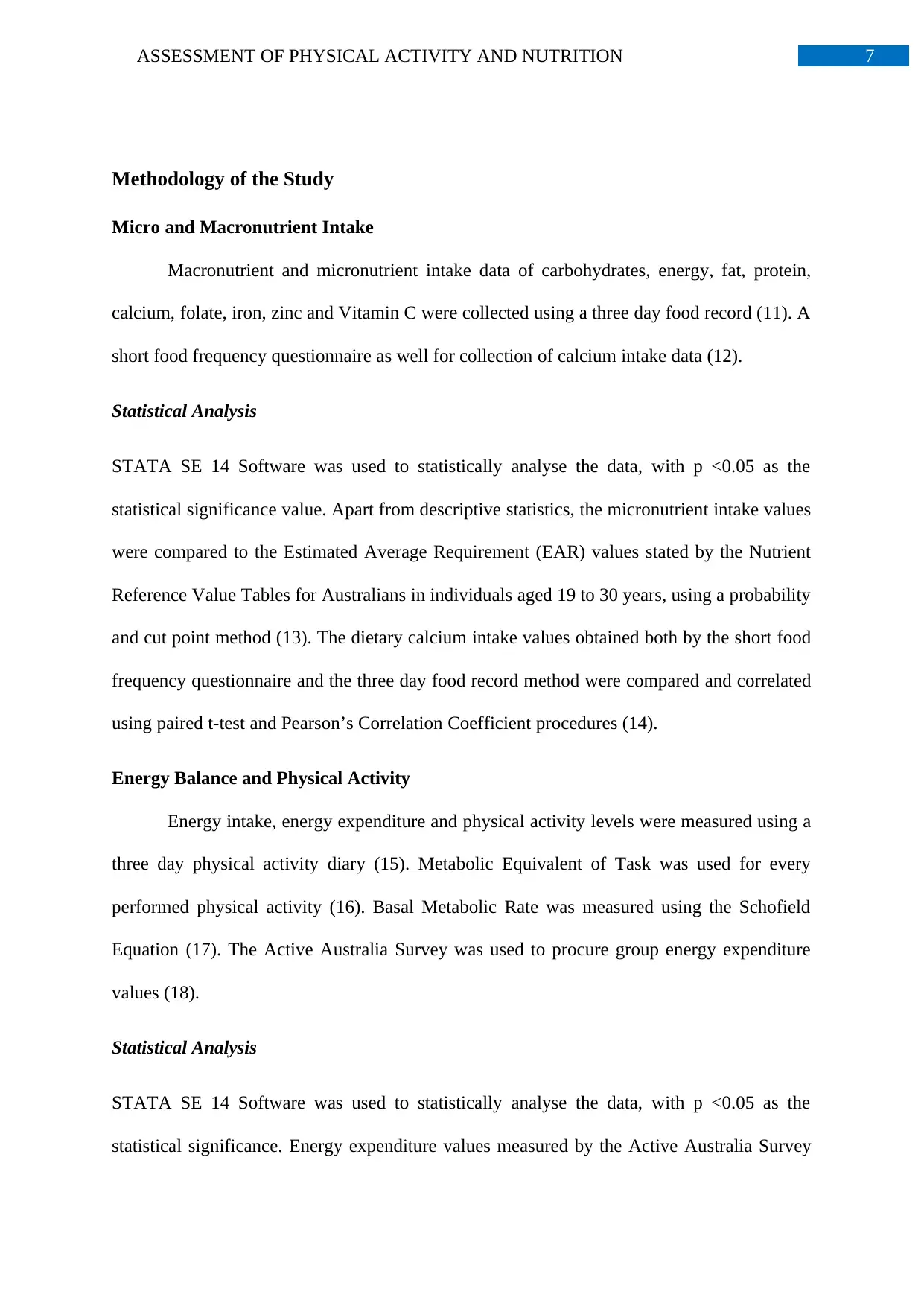
Methodology of the Study
Micro and Macronutrient Intake
Macronutrient and micronutrient intake data of carbohydrates, energy, fat, protein,
calcium, folate, iron, zinc and Vitamin C were collected using a three day food record (11). A
short food frequency questionnaire as well for collection of calcium intake data (12).
Statistical Analysis
STATA SE 14 Software was used to statistically analyse the data, with p <0.05 as the
statistical significance value. Apart from descriptive statistics, the micronutrient intake values
were compared to the Estimated Average Requirement (EAR) values stated by the Nutrient
Reference Value Tables for Australians in individuals aged 19 to 30 years, using a probability
and cut point method (13). The dietary calcium intake values obtained both by the short food
frequency questionnaire and the three day food record method were compared and correlated
using paired t-test and Pearson’s Correlation Coefficient procedures (14).
Energy Balance and Physical Activity
Energy intake, energy expenditure and physical activity levels were measured using a
three day physical activity diary (15). Metabolic Equivalent of Task was used for every
performed physical activity (16). Basal Metabolic Rate was measured using the Schofield
Equation (17). The Active Australia Survey was used to procure group energy expenditure
values (18).
Statistical Analysis
STATA SE 14 Software was used to statistically analyse the data, with p <0.05 as the
statistical significance. Energy expenditure values measured by the Active Australia Survey
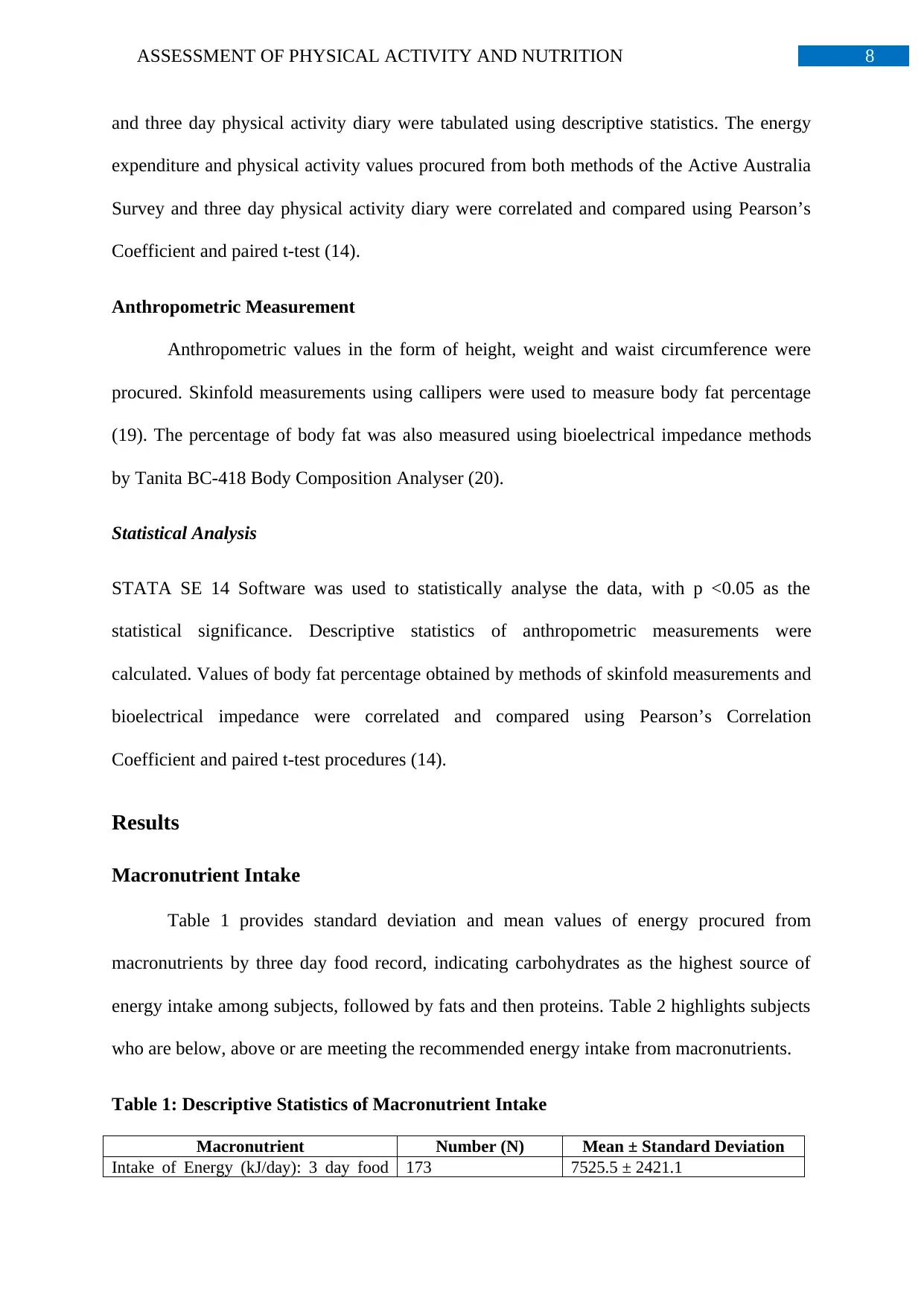
and three day physical activity diary were tabulated using descriptive statistics. The energy
expenditure and physical activity values procured from both methods of the Active Australia
Survey and three day physical activity diary were correlated and compared using Pearson’s
Coefficient and paired t-test (14).
Anthropometric Measurement
Anthropometric values in the form of height, weight and waist circumference were
procured. Skinfold measurements using callipers were used to measure body fat percentage
(19). The percentage of body fat was also measured using bioelectrical impedance methods
by Tanita BC-418 Body Composition Analyser (20).
Statistical Analysis
STATA SE 14 Software was used to statistically analyse the data, with p <0.05 as the
statistical significance. Descriptive statistics of anthropometric measurements were
calculated. Values of body fat percentage obtained by methods of skinfold measurements and
bioelectrical impedance were correlated and compared using Pearson’s Correlation
Coefficient and paired t-test procedures (14).
Results
Macronutrient Intake
Table 1 provides standard deviation and mean values of energy procured from
macronutrients by three day food record, indicating carbohydrates as the highest source of
energy intake among subjects, followed by fats and then proteins. Table 2 highlights subjects
who are below, above or are meeting the recommended energy intake from macronutrients.
Table 1: Descriptive Statistics of Macronutrient Intake
Macronutrient Number (N) Mean ± Standard Deviation
Intake of Energy (kJ/day): 3 day food 173 7525.5 ± 2421.1
⊘ This is a preview!⊘
Do you want full access?
Subscribe today to unlock all pages.

Trusted by 1+ million students worldwide
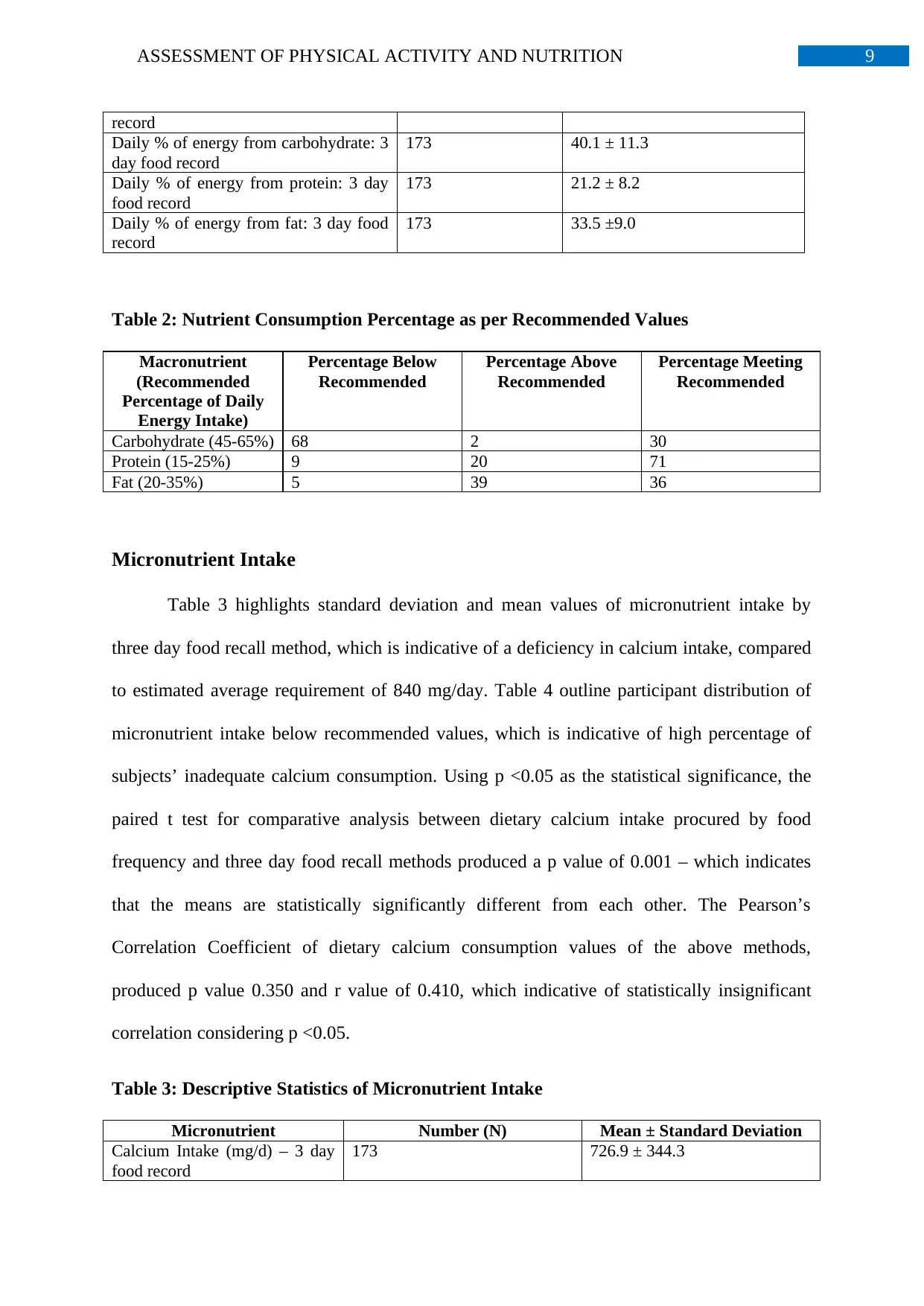
record
Daily % of energy from carbohydrate: 3
day food record
173 40.1 ± 11.3
Daily % of energy from protein: 3 day
food record
173 21.2 ± 8.2
Daily % of energy from fat: 3 day food
record
173 33.5 ±9.0
Table 2: Nutrient Consumption Percentage as per Recommended Values
Macronutrient
(Recommended
Percentage of Daily
Energy Intake)
Percentage Below
Recommended
Percentage Above
Recommended
Percentage Meeting
Recommended
Carbohydrate (45-65%) 68 2 30
Protein (15-25%) 9 20 71
Fat (20-35%) 5 39 36
Micronutrient Intake
Table 3 highlights standard deviation and mean values of micronutrient intake by
three day food recall method, which is indicative of a deficiency in calcium intake, compared
to estimated average requirement of 840 mg/day. Table 4 outline participant distribution of
micronutrient intake below recommended values, which is indicative of high percentage of
subjects’ inadequate calcium consumption. Using p <0.05 as the statistical significance, the
paired t test for comparative analysis between dietary calcium intake procured by food
frequency and three day food recall methods produced a p value of 0.001 – which indicates
that the means are statistically significantly different from each other. The Pearson’s
Correlation Coefficient of dietary calcium consumption values of the above methods,
produced p value 0.350 and r value of 0.410, which indicative of statistically insignificant
correlation considering p <0.05.
Table 3: Descriptive Statistics of Micronutrient Intake
Micronutrient Number (N) Mean ± Standard Deviation
Calcium Intake (mg/d) – 3 day
food record
173 726.9 ± 344.3
Paraphrase This Document

Calcium Intake (mg/d) – Food
Frequency Questionnaire
173 630.7 ± 447.6
Iron Intake (mg/d) – 3 day food
record
173 11.7 ± 5.8
Folate Intake (ug/d) – 3 day
food record
173 391.2 ± 180.1
Zinc Intake (mg/d) – 3 day food
record
173 10.9 ± 7.7
Vitamin C (mg/d) – 3 day food
record
173 105.1 ± 72.1
Table 4: Inadequacy of Micronutrient Intake
Micronutrient Number Below Estimated
Average Requirement (EAR)
% Below EAR
Calcium 118 68.21%
Folate 61 35.26%
Vitamin C 17 9.83%
Zinc (Women) 34 19.65%
Iron (Women) 87 50.33%
Energy Intake and Expenditure
Table 5 highlights descriptive statistics of energy expenditure and intake values
procured from the Active Australia Survey and three day diary methods. Using p <0.05 as the
statistical significance, the paired t test to between the mean energy expenditure values
procured from the Active Australia Survey and three day diary methods produced a p value
of <0.001, which is indicative of the statistically significant difference between the two. The
methods are also statistically insignificantly correlated as observed from p value of 0.640 and
r value of 0.040 from Pearson’s Correlation Coefficient methods ( p <0.05).
Table 5: Descriptive Statistics of Energy Intake and Expenditure
Energy Intake and
Expenditure
Number (N) Mean ± Standard Deviation
Energy Intake (kJ/d) – 3 day
diary
173 7525 ± 2421
Energy Expenditure (kJ/d) – 3
day diary
173 8290 ± 4242
Energy Expenditure (kJ/d) –
Active Australia Survey
173 1098 ± 1054
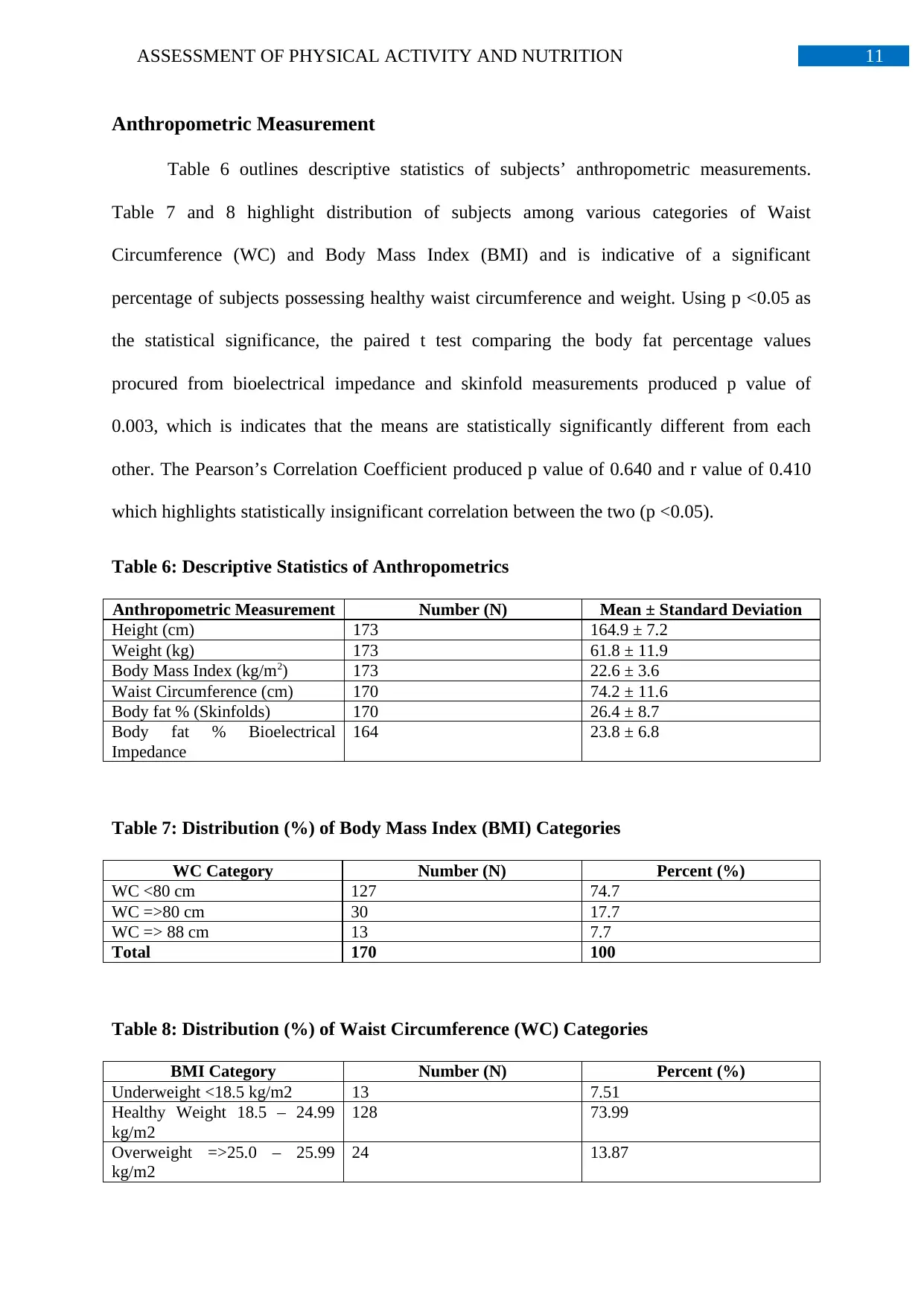
Anthropometric Measurement
Table 6 outlines descriptive statistics of subjects’ anthropometric measurements.
Table 7 and 8 highlight distribution of subjects among various categories of Waist
Circumference (WC) and Body Mass Index (BMI) and is indicative of a significant
percentage of subjects possessing healthy waist circumference and weight. Using p <0.05 as
the statistical significance, the paired t test comparing the body fat percentage values
procured from bioelectrical impedance and skinfold measurements produced p value of
0.003, which is indicates that the means are statistically significantly different from each
other. The Pearson’s Correlation Coefficient produced p value of 0.640 and r value of 0.410
which highlights statistically insignificant correlation between the two (p <0.05).
Table 6: Descriptive Statistics of Anthropometrics
Anthropometric Measurement Number (N) Mean ± Standard Deviation
Height (cm) 173 164.9 ± 7.2
Weight (kg) 173 61.8 ± 11.9
Body Mass Index (kg/m2) 173 22.6 ± 3.6
Waist Circumference (cm) 170 74.2 ± 11.6
Body fat % (Skinfolds) 170 26.4 ± 8.7
Body fat % Bioelectrical
Impedance
164 23.8 ± 6.8
Table 7: Distribution (%) of Body Mass Index (BMI) Categories
WC Category Number (N) Percent (%)
WC <80 cm 127 74.7
WC =>80 cm 30 17.7
WC => 88 cm 13 7.7
Total 170 100
Table 8: Distribution (%) of Waist Circumference (WC) Categories
BMI Category Number (N) Percent (%)
Underweight <18.5 kg/m2 13 7.51
Healthy Weight 18.5 – 24.99
kg/m2
128 73.99
Overweight =>25.0 – 25.99
kg/m2
24 13.87
⊘ This is a preview!⊘
Do you want full access?
Subscribe today to unlock all pages.

Trusted by 1+ million students worldwide
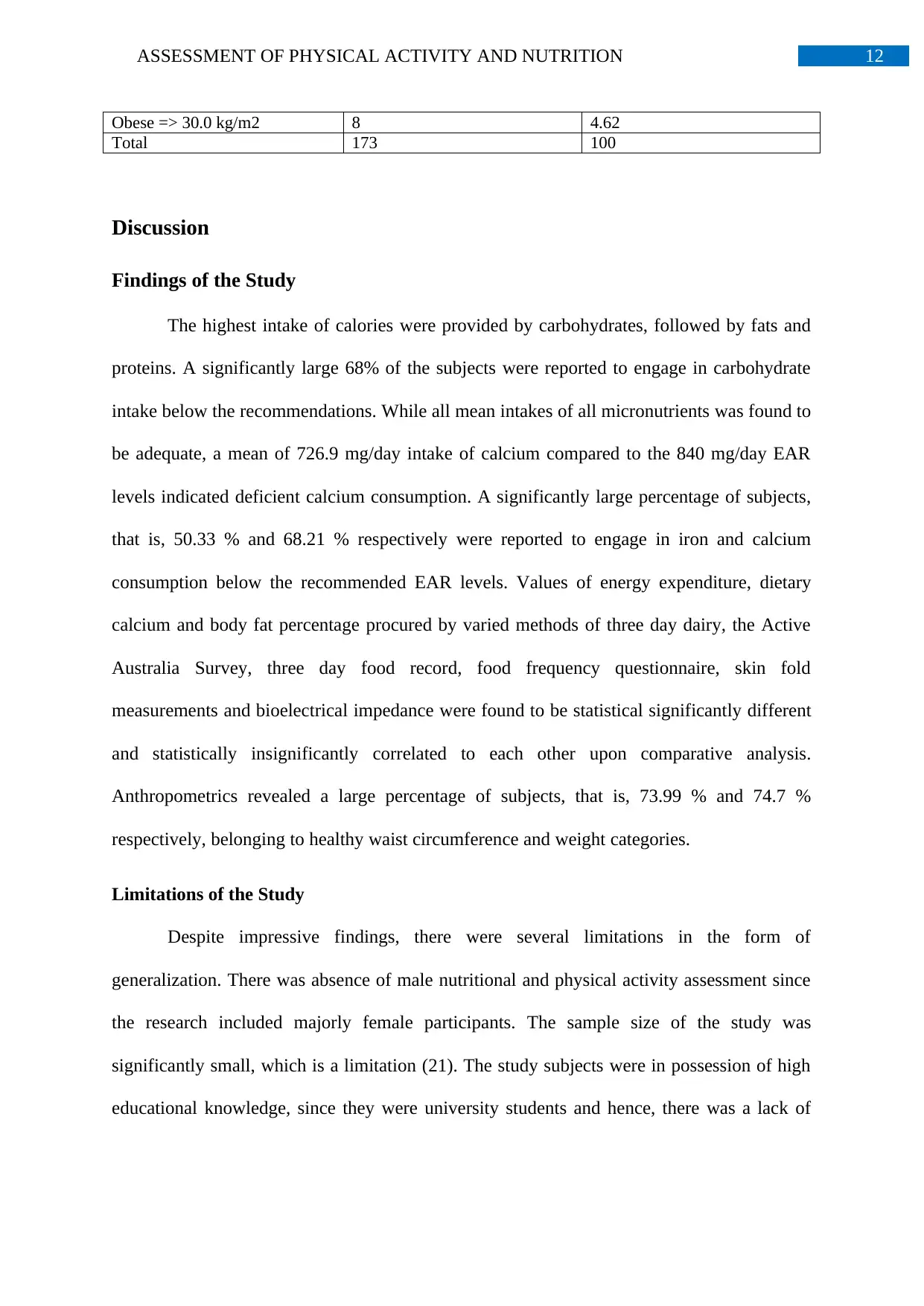
Obese => 30.0 kg/m2 8 4.62
Total 173 100
Discussion
Findings of the Study
The highest intake of calories were provided by carbohydrates, followed by fats and
proteins. A significantly large 68% of the subjects were reported to engage in carbohydrate
intake below the recommendations. While all mean intakes of all micronutrients was found to
be adequate, a mean of 726.9 mg/day intake of calcium compared to the 840 mg/day EAR
levels indicated deficient calcium consumption. A significantly large percentage of subjects,
that is, 50.33 % and 68.21 % respectively were reported to engage in iron and calcium
consumption below the recommended EAR levels. Values of energy expenditure, dietary
calcium and body fat percentage procured by varied methods of three day dairy, the Active
Australia Survey, three day food record, food frequency questionnaire, skin fold
measurements and bioelectrical impedance were found to be statistical significantly different
and statistically insignificantly correlated to each other upon comparative analysis.
Anthropometrics revealed a large percentage of subjects, that is, 73.99 % and 74.7 %
respectively, belonging to healthy waist circumference and weight categories.
Limitations of the Study
Despite impressive findings, there were several limitations in the form of
generalization. There was absence of male nutritional and physical activity assessment since
the research included majorly female participants. The sample size of the study was
significantly small, which is a limitation (21). The study subjects were in possession of high
educational knowledge, since they were university students and hence, there was a lack of
Paraphrase This Document

nutrition and physical activity assessments of subjects belonging to different academic
backgrounds (22).
Comparison with Australian Norms and Standards
The above data was compared with the results of the Australian Health Survey (2011-
2012) which indicated that the above findings were similar to the results of the survey, where
subjects procured highest calories from carbohydrates (40.1%), followed by fat (33.5%) and
protein (21.2%) (23). Upon comparison with the Nutrient Reference Values for Australia and
New Zealand, a large number of subjects derived calories from carbohydrates below the
recommended values, while 39% of subjects procured calories from fats above the
recommendations and 71% procuring recommended calories from proteins. Comparing the
micronutrient EAR values stated by the Nutrient Reference Values for Australia and New
Zealand, 68.21% of subjects did not meet the recommended intake of 840 mg/day of calcium
(24). This finding showed similarity to the Australian Health Survey (2011-2012) which also
displayed a deficiency of calcium consumption by females (23). Since both studies engaged
in food recall procedures, the findings may show similarity for this reason (25). However,
there still may be errors in both due to utilization of surveys, since incorrectness of reporting
and subject bias are major disadvantages of surveys (26). Deficiency in calcium consumption
is alarming and must be corrected immediately, since the inadequacy may lead to high
susceptibility of osteoporosis, inadequate bone strength and density and future fractures
resulting from falls (27). The high subject percentage of iron consumption as per EAR values
must also be corrected to prevent anaemia and its associated symptoms in the future (28).
Upon comparison with the Clinical Practice Guidelines for the Management of
Overweight and Obesity in Adults, Adolescents and Children in Australia’, the reported that
73.99% and 74.7 % of the subjects belonged to healthy categories of weight and waist
circumferences (29). Such findings differed from the Australian Health Survey (2014-2015),
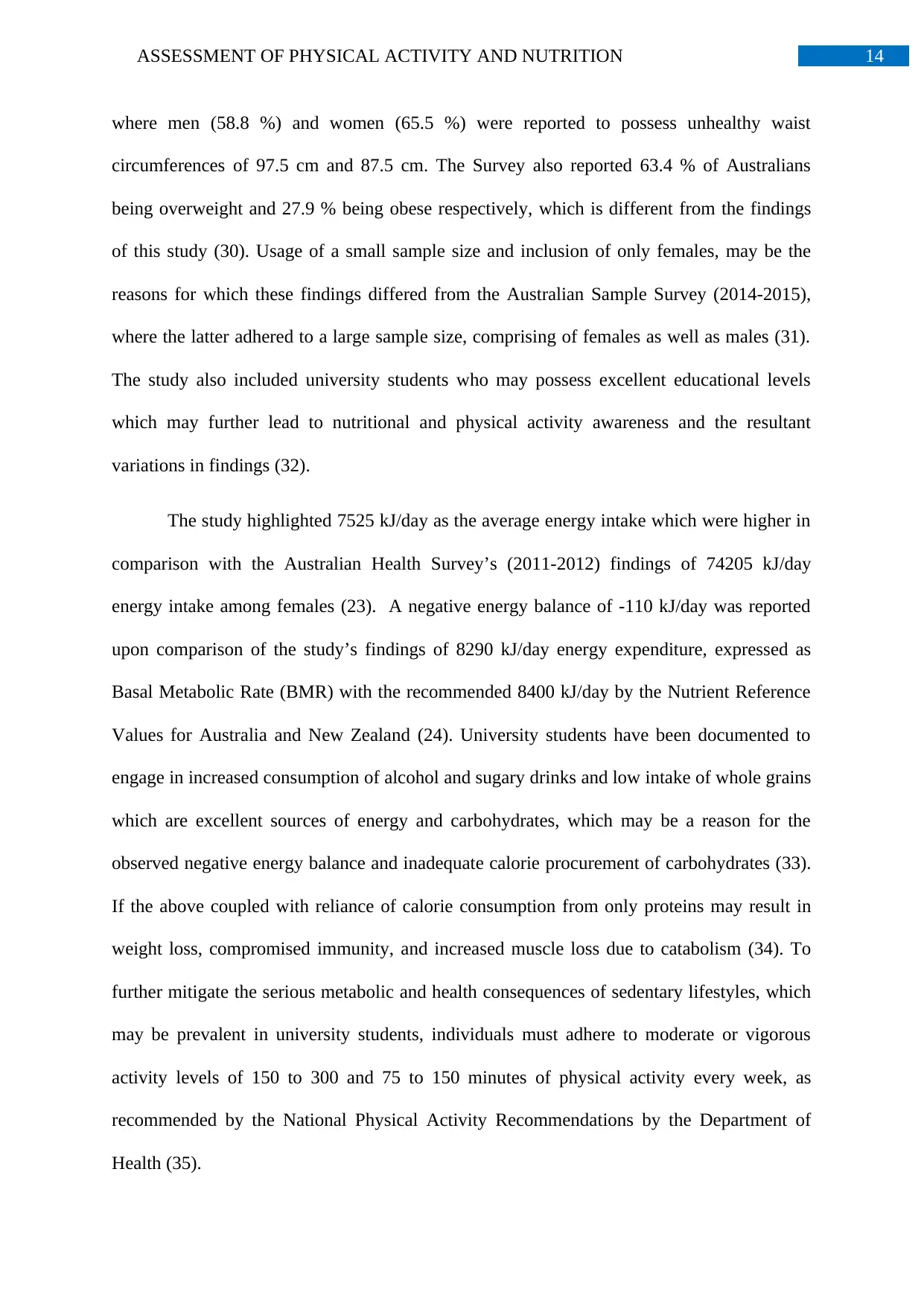
where men (58.8 %) and women (65.5 %) were reported to possess unhealthy waist
circumferences of 97.5 cm and 87.5 cm. The Survey also reported 63.4 % of Australians
being overweight and 27.9 % being obese respectively, which is different from the findings
of this study (30). Usage of a small sample size and inclusion of only females, may be the
reasons for which these findings differed from the Australian Sample Survey (2014-2015),
where the latter adhered to a large sample size, comprising of females as well as males (31).
The study also included university students who may possess excellent educational levels
which may further lead to nutritional and physical activity awareness and the resultant
variations in findings (32).
The study highlighted 7525 kJ/day as the average energy intake which were higher in
comparison with the Australian Health Survey’s (2011-2012) findings of 74205 kJ/day
energy intake among females (23). A negative energy balance of -110 kJ/day was reported
upon comparison of the study’s findings of 8290 kJ/day energy expenditure, expressed as
Basal Metabolic Rate (BMR) with the recommended 8400 kJ/day by the Nutrient Reference
Values for Australia and New Zealand (24). University students have been documented to
engage in increased consumption of alcohol and sugary drinks and low intake of whole grains
which are excellent sources of energy and carbohydrates, which may be a reason for the
observed negative energy balance and inadequate calorie procurement of carbohydrates (33).
If the above coupled with reliance of calorie consumption from only proteins may result in
weight loss, compromised immunity, and increased muscle loss due to catabolism (34). To
further mitigate the serious metabolic and health consequences of sedentary lifestyles, which
may be prevalent in university students, individuals must adhere to moderate or vigorous
activity levels of 150 to 300 and 75 to 150 minutes of physical activity every week, as
recommended by the National Physical Activity Recommendations by the Department of
Health (35).
⊘ This is a preview!⊘
Do you want full access?
Subscribe today to unlock all pages.

Trusted by 1+ million students worldwide

Intake of Calcium
Dietary calcium intakes procured by the food frequency questionnaire and the three
day food record methods were observed to be insignificantly correlated and statistically
significantly different from each other. A food frequency questionnaire is more accurate since
it allows for participants to report the frequency with which they consumed a fixed category
of foods, as compared to a three day food record where participants may find it difficult to
remember their consumption over the last 72 hours – a possible reason for such differences.
An additional reason for such differences, may be possibilities of underestimation by food
frequency questionnaires since accurately highlighting the frequency of consumption coupled
with provision of only a fixed list of foods, may be a difficult and complex task for
individuals (36).
Energy Expenditure
The data of energy expenditure estimated by the Active Australia Survey and three
day records were found to be insignificantly correlated and statistically significantly different
from each other. A food recall method may be more accurate since it reports an individual’s
physical activity and food consumption over a three day period, as compared to the
possibilities of bias prevalent in a survey used by the Active Australia Survey – which may
be a key reason of differences between the two. Further, the Active Australia Survey utilises
questions which requests individuals to recall their levels of physical activity for the last 12
months or 7 days, which is susceptible to incorrectness due to forgetfulness in comparison to
a three day diary, which only requires details of the past 72 hours, hence leading to
differences (37).
Paraphrase This Document
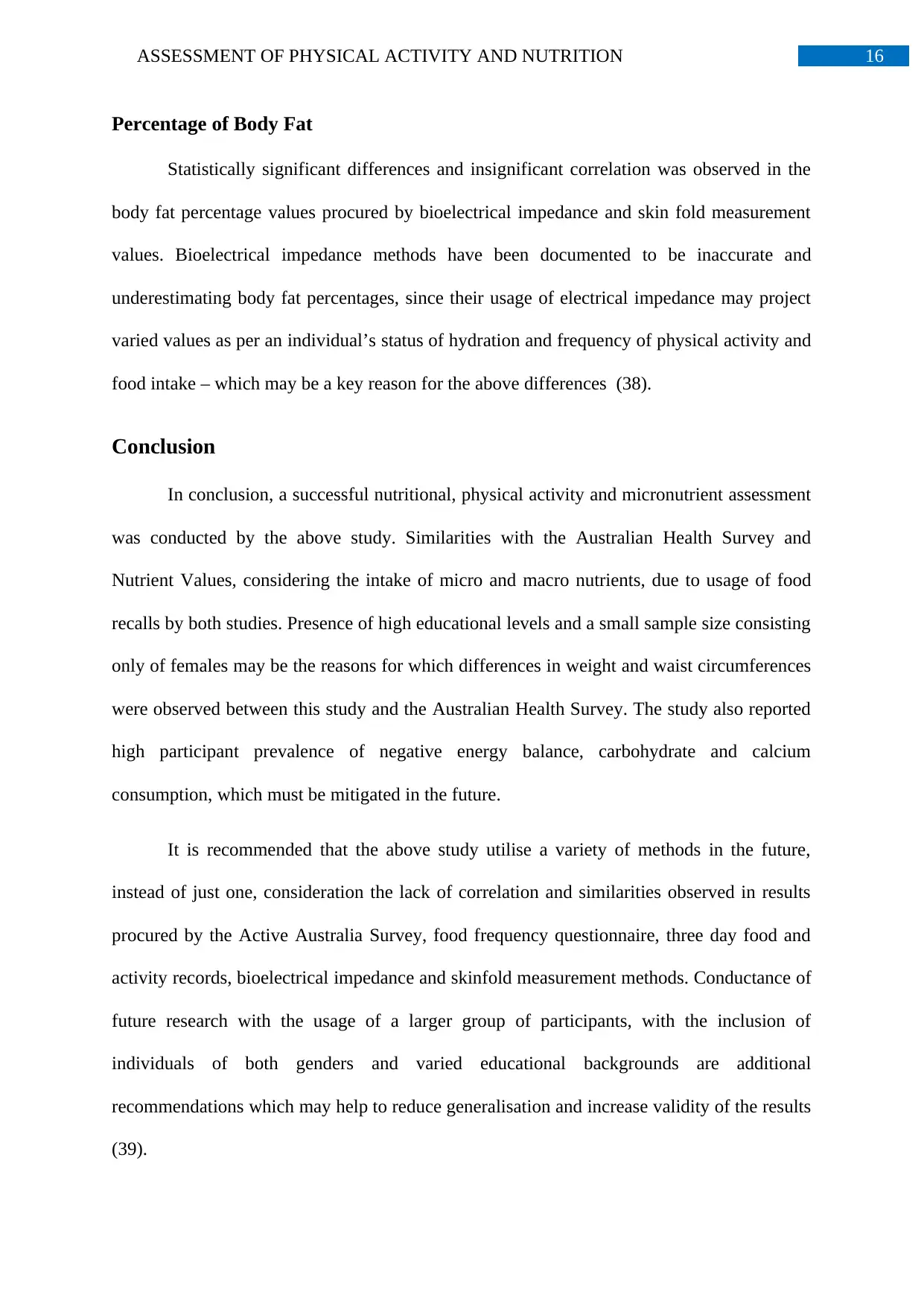
Percentage of Body Fat
Statistically significant differences and insignificant correlation was observed in the
body fat percentage values procured by bioelectrical impedance and skin fold measurement
values. Bioelectrical impedance methods have been documented to be inaccurate and
underestimating body fat percentages, since their usage of electrical impedance may project
varied values as per an individual’s status of hydration and frequency of physical activity and
food intake – which may be a key reason for the above differences (38).
Conclusion
In conclusion, a successful nutritional, physical activity and micronutrient assessment
was conducted by the above study. Similarities with the Australian Health Survey and
Nutrient Values, considering the intake of micro and macro nutrients, due to usage of food
recalls by both studies. Presence of high educational levels and a small sample size consisting
only of females may be the reasons for which differences in weight and waist circumferences
were observed between this study and the Australian Health Survey. The study also reported
high participant prevalence of negative energy balance, carbohydrate and calcium
consumption, which must be mitigated in the future.
It is recommended that the above study utilise a variety of methods in the future,
instead of just one, consideration the lack of correlation and similarities observed in results
procured by the Active Australia Survey, food frequency questionnaire, three day food and
activity records, bioelectrical impedance and skinfold measurement methods. Conductance of
future research with the usage of a larger group of participants, with the inclusion of
individuals of both genders and varied educational backgrounds are additional
recommendations which may help to reduce generalisation and increase validity of the results
(39).
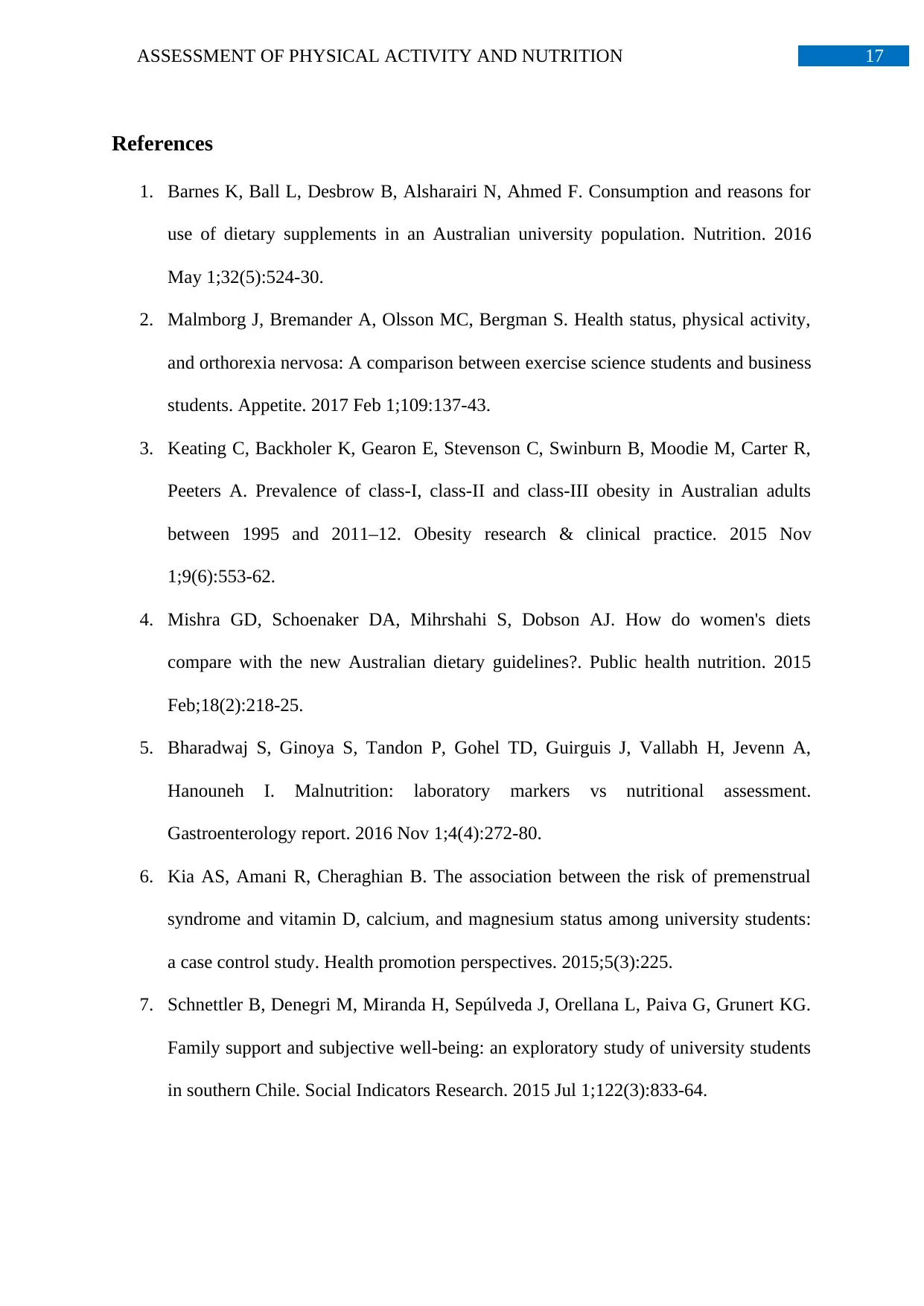
References
1. Barnes K, Ball L, Desbrow B, Alsharairi N, Ahmed F. Consumption and reasons for
use of dietary supplements in an Australian university population. Nutrition. 2016
May 1;32(5):524-30.
2. Malmborg J, Bremander A, Olsson MC, Bergman S. Health status, physical activity,
and orthorexia nervosa: A comparison between exercise science students and business
students. Appetite. 2017 Feb 1;109:137-43.
3. Keating C, Backholer K, Gearon E, Stevenson C, Swinburn B, Moodie M, Carter R,
Peeters A. Prevalence of class-I, class-II and class-III obesity in Australian adults
between 1995 and 2011–12. Obesity research & clinical practice. 2015 Nov
1;9(6):553-62.
4. Mishra GD, Schoenaker DA, Mihrshahi S, Dobson AJ. How do women's diets
compare with the new Australian dietary guidelines?. Public health nutrition. 2015
Feb;18(2):218-25.
5. Bharadwaj S, Ginoya S, Tandon P, Gohel TD, Guirguis J, Vallabh H, Jevenn A,
Hanouneh I. Malnutrition: laboratory markers vs nutritional assessment.
Gastroenterology report. 2016 Nov 1;4(4):272-80.
6. Kia AS, Amani R, Cheraghian B. The association between the risk of premenstrual
syndrome and vitamin D, calcium, and magnesium status among university students:
a case control study. Health promotion perspectives. 2015;5(3):225.
7. Schnettler B, Denegri M, Miranda H, Sepúlveda J, Orellana L, Paiva G, Grunert KG.
Family support and subjective well-being: an exploratory study of university students
in southern Chile. Social Indicators Research. 2015 Jul 1;122(3):833-64.
⊘ This is a preview!⊘
Do you want full access?
Subscribe today to unlock all pages.

Trusted by 1+ million students worldwide
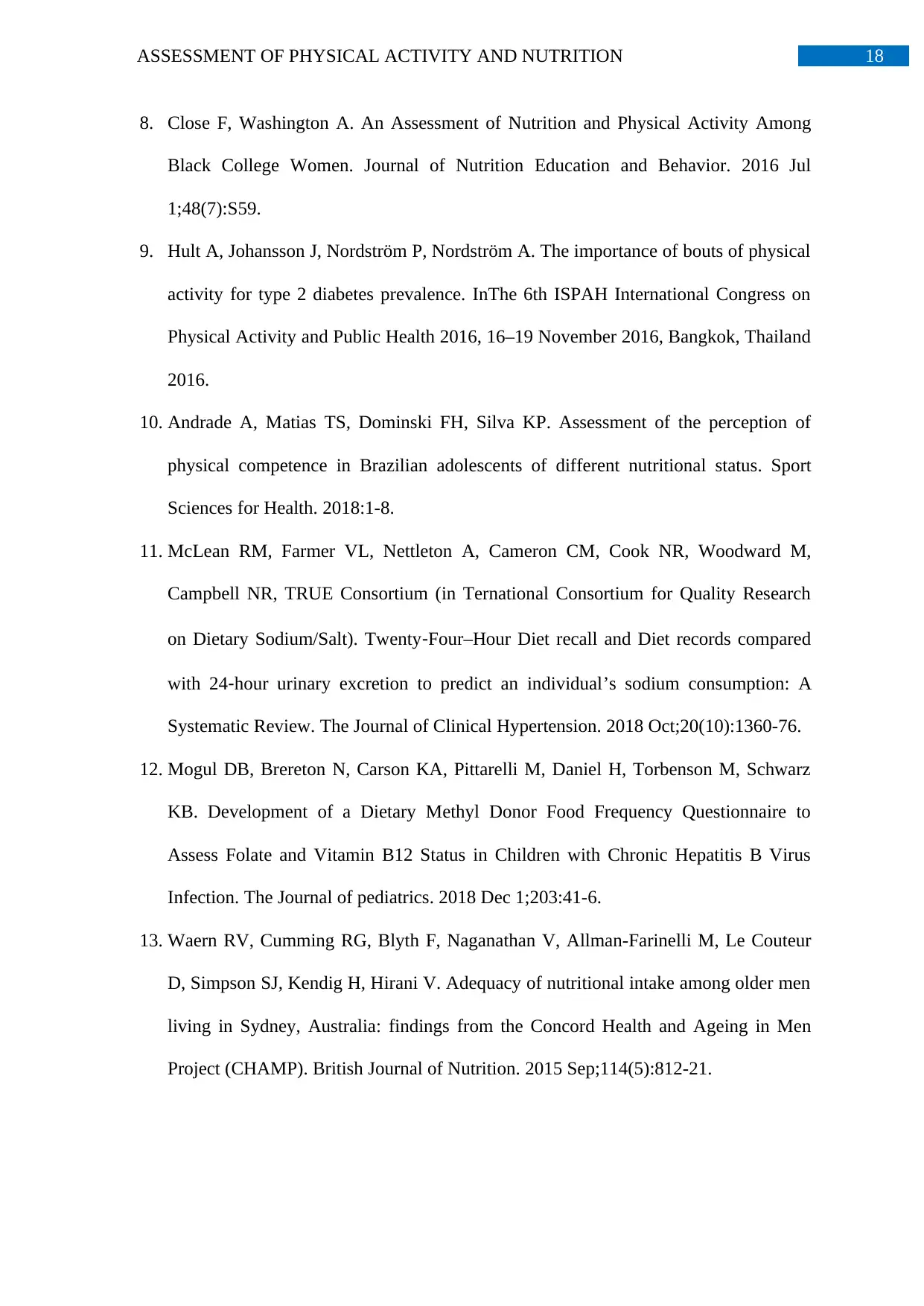
8. Close F, Washington A. An Assessment of Nutrition and Physical Activity Among
Black College Women. Journal of Nutrition Education and Behavior. 2016 Jul
1;48(7):S59.
9. Hult A, Johansson J, Nordström P, Nordström A. The importance of bouts of physical
activity for type 2 diabetes prevalence. InThe 6th ISPAH International Congress on
Physical Activity and Public Health 2016, 16–19 November 2016, Bangkok, Thailand
2016.
10. Andrade A, Matias TS, Dominski FH, Silva KP. Assessment of the perception of
physical competence in Brazilian adolescents of different nutritional status. Sport
Sciences for Health. 2018:1-8.
11. McLean RM, Farmer VL, Nettleton A, Cameron CM, Cook NR, Woodward M,
Campbell NR, TRUE Consortium (in Ternational Consortium for Quality Research
on Dietary Sodium/Salt). Twenty‐Four–Hour Diet recall and Diet records compared
with 24‐hour urinary excretion to predict an individual’s sodium consumption: A
Systematic Review. The Journal of Clinical Hypertension. 2018 Oct;20(10):1360-76.
12. Mogul DB, Brereton N, Carson KA, Pittarelli M, Daniel H, Torbenson M, Schwarz
KB. Development of a Dietary Methyl Donor Food Frequency Questionnaire to
Assess Folate and Vitamin B12 Status in Children with Chronic Hepatitis B Virus
Infection. The Journal of pediatrics. 2018 Dec 1;203:41-6.
13. Waern RV, Cumming RG, Blyth F, Naganathan V, Allman-Farinelli M, Le Couteur
D, Simpson SJ, Kendig H, Hirani V. Adequacy of nutritional intake among older men
living in Sydney, Australia: findings from the Concord Health and Ageing in Men
Project (CHAMP). British Journal of Nutrition. 2015 Sep;114(5):812-21.
Paraphrase This Document
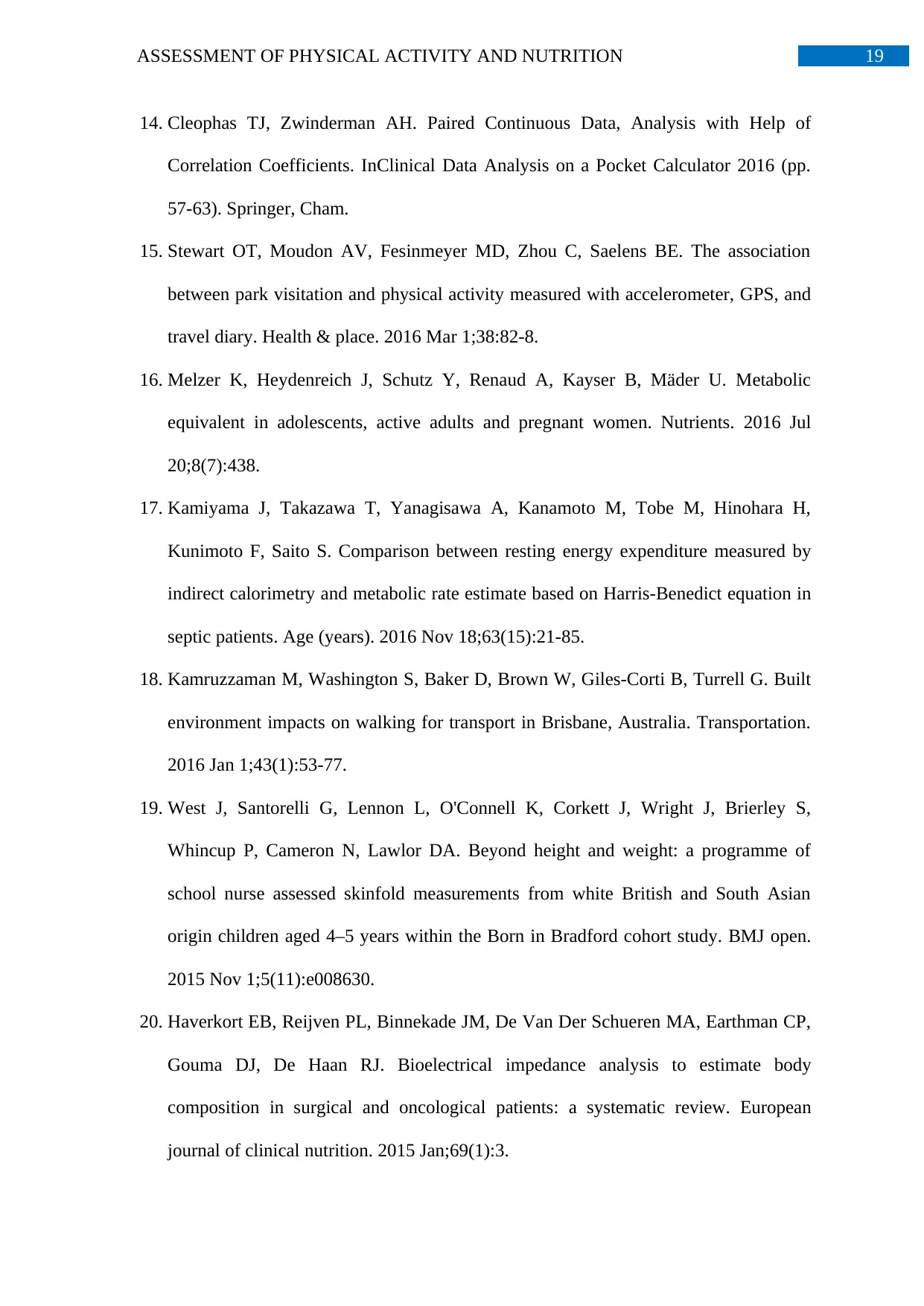
14. Cleophas TJ, Zwinderman AH. Paired Continuous Data, Analysis with Help of
Correlation Coefficients. InClinical Data Analysis on a Pocket Calculator 2016 (pp.
57-63). Springer, Cham.
15. Stewart OT, Moudon AV, Fesinmeyer MD, Zhou C, Saelens BE. The association
between park visitation and physical activity measured with accelerometer, GPS, and
travel diary. Health & place. 2016 Mar 1;38:82-8.
16. Melzer K, Heydenreich J, Schutz Y, Renaud A, Kayser B, Mäder U. Metabolic
equivalent in adolescents, active adults and pregnant women. Nutrients. 2016 Jul
20;8(7):438.
17. Kamiyama J, Takazawa T, Yanagisawa A, Kanamoto M, Tobe M, Hinohara H,
Kunimoto F, Saito S. Comparison between resting energy expenditure measured by
indirect calorimetry and metabolic rate estimate based on Harris-Benedict equation in
septic patients. Age (years). 2016 Nov 18;63(15):21-85.
18. Kamruzzaman M, Washington S, Baker D, Brown W, Giles-Corti B, Turrell G. Built
environment impacts on walking for transport in Brisbane, Australia. Transportation.
2016 Jan 1;43(1):53-77.
19. West J, Santorelli G, Lennon L, O'Connell K, Corkett J, Wright J, Brierley S,
Whincup P, Cameron N, Lawlor DA. Beyond height and weight: a programme of
school nurse assessed skinfold measurements from white British and South Asian
origin children aged 4–5 years within the Born in Bradford cohort study. BMJ open.
2015 Nov 1;5(11):e008630.
20. Haverkort EB, Reijven PL, Binnekade JM, De Van Der Schueren MA, Earthman CP,
Gouma DJ, De Haan RJ. Bioelectrical impedance analysis to estimate body
composition in surgical and oncological patients: a systematic review. European
journal of clinical nutrition. 2015 Jan;69(1):3.
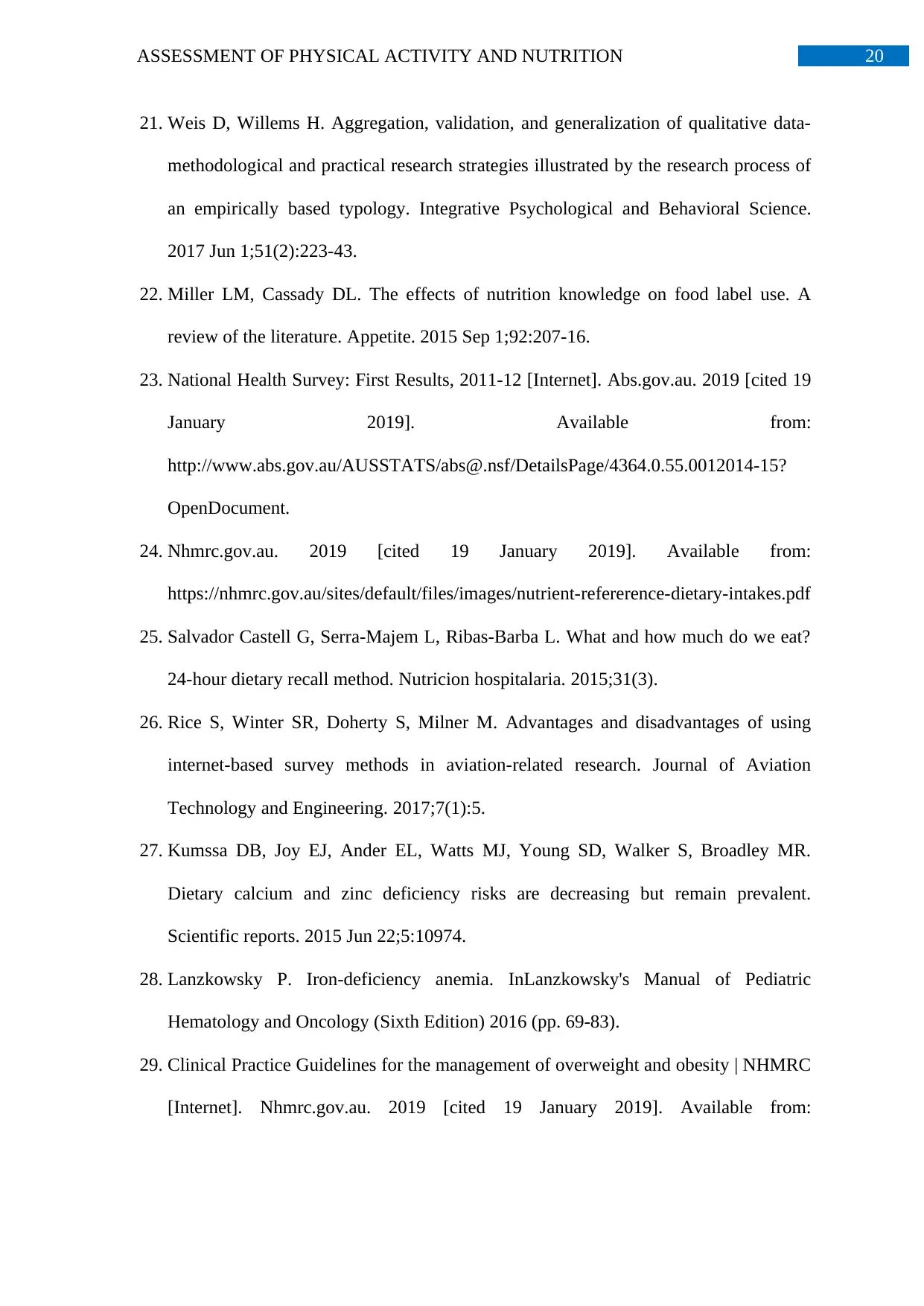
21. Weis D, Willems H. Aggregation, validation, and generalization of qualitative data-
methodological and practical research strategies illustrated by the research process of
an empirically based typology. Integrative Psychological and Behavioral Science.
2017 Jun 1;51(2):223-43.
22. Miller LM, Cassady DL. The effects of nutrition knowledge on food label use. A
review of the literature. Appetite. 2015 Sep 1;92:207-16.
23. National Health Survey: First Results, 2011-12 [Internet]. Abs.gov.au. 2019 [cited 19
January 2019]. Available from:
http://www.abs.gov.au/AUSSTATS/abs@.nsf/DetailsPage/4364.0.55.0012014-15?
OpenDocument.
24. Nhmrc.gov.au. 2019 [cited 19 January 2019]. Available from:
https://nhmrc.gov.au/sites/default/files/images/nutrient-refererence-dietary-intakes.pdf
25. Salvador Castell G, Serra-Majem L, Ribas-Barba L. What and how much do we eat?
24-hour dietary recall method. Nutricion hospitalaria. 2015;31(3).
26. Rice S, Winter SR, Doherty S, Milner M. Advantages and disadvantages of using
internet-based survey methods in aviation-related research. Journal of Aviation
Technology and Engineering. 2017;7(1):5.
27. Kumssa DB, Joy EJ, Ander EL, Watts MJ, Young SD, Walker S, Broadley MR.
Dietary calcium and zinc deficiency risks are decreasing but remain prevalent.
Scientific reports. 2015 Jun 22;5:10974.
28. Lanzkowsky P. Iron-deficiency anemia. InLanzkowsky's Manual of Pediatric
Hematology and Oncology (Sixth Edition) 2016 (pp. 69-83).
29. Clinical Practice Guidelines for the management of overweight and obesity | NHMRC
[Internet]. Nhmrc.gov.au. 2019 [cited 19 January 2019]. Available from:
⊘ This is a preview!⊘
Do you want full access?
Subscribe today to unlock all pages.

Trusted by 1+ million students worldwide
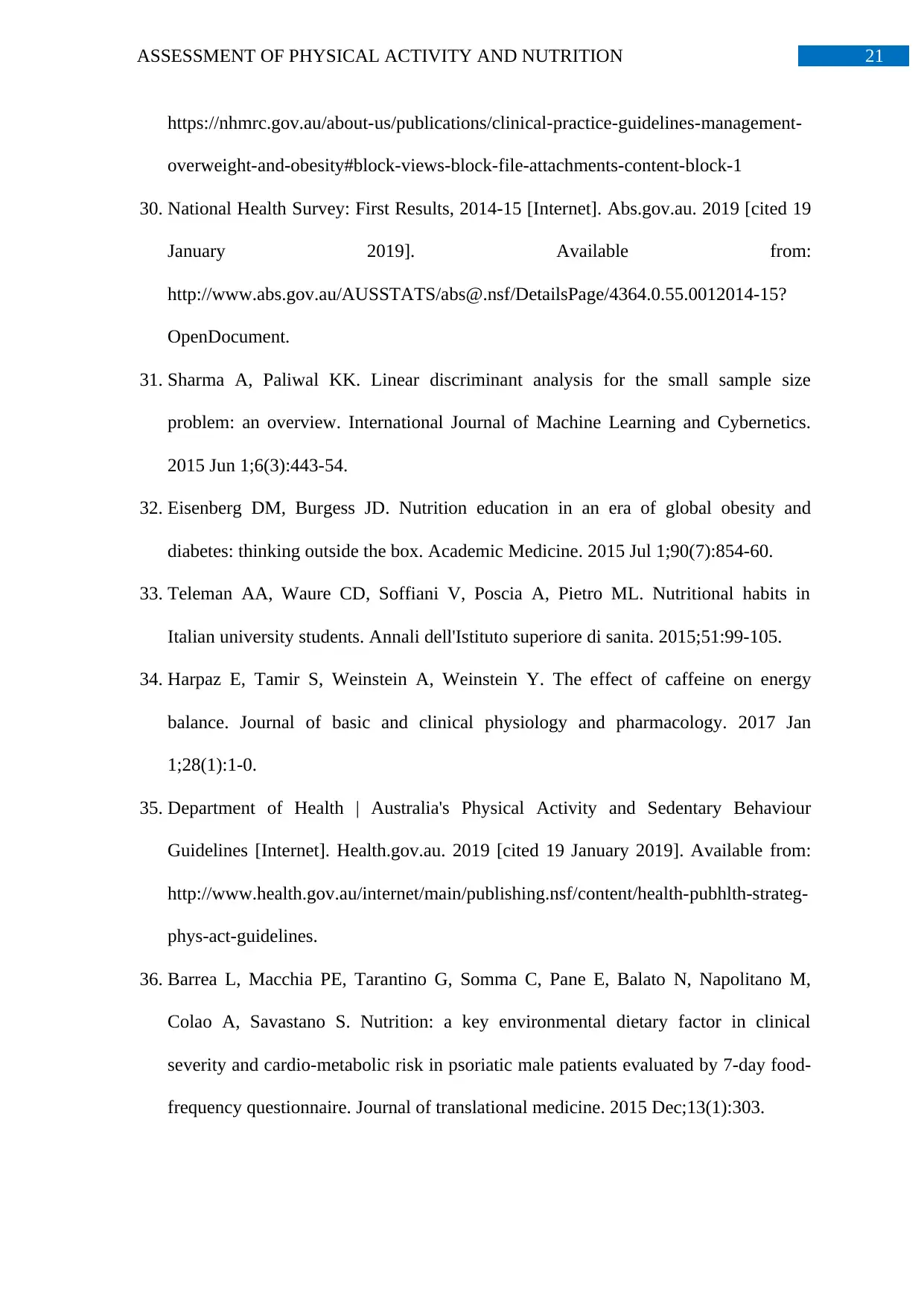
https://nhmrc.gov.au/about-us/publications/clinical-practice-guidelines-management-
overweight-and-obesity#block-views-block-file-attachments-content-block-1
30. National Health Survey: First Results, 2014-15 [Internet]. Abs.gov.au. 2019 [cited 19
January 2019]. Available from:
http://www.abs.gov.au/AUSSTATS/abs@.nsf/DetailsPage/4364.0.55.0012014-15?
OpenDocument.
31. Sharma A, Paliwal KK. Linear discriminant analysis for the small sample size
problem: an overview. International Journal of Machine Learning and Cybernetics.
2015 Jun 1;6(3):443-54.
32. Eisenberg DM, Burgess JD. Nutrition education in an era of global obesity and
diabetes: thinking outside the box. Academic Medicine. 2015 Jul 1;90(7):854-60.
33. Teleman AA, Waure CD, Soffiani V, Poscia A, Pietro ML. Nutritional habits in
Italian university students. Annali dell'Istituto superiore di sanita. 2015;51:99-105.
34. Harpaz E, Tamir S, Weinstein A, Weinstein Y. The effect of caffeine on energy
balance. Journal of basic and clinical physiology and pharmacology. 2017 Jan
1;28(1):1-0.
35. Department of Health | Australia's Physical Activity and Sedentary Behaviour
Guidelines [Internet]. Health.gov.au. 2019 [cited 19 January 2019]. Available from:
http://www.health.gov.au/internet/main/publishing.nsf/content/health-pubhlth-strateg-
phys-act-guidelines.
36. Barrea L, Macchia PE, Tarantino G, Somma C, Pane E, Balato N, Napolitano M,
Colao A, Savastano S. Nutrition: a key environmental dietary factor in clinical
severity and cardio-metabolic risk in psoriatic male patients evaluated by 7-day food-
frequency questionnaire. Journal of translational medicine. 2015 Dec;13(1):303.
Paraphrase This Document
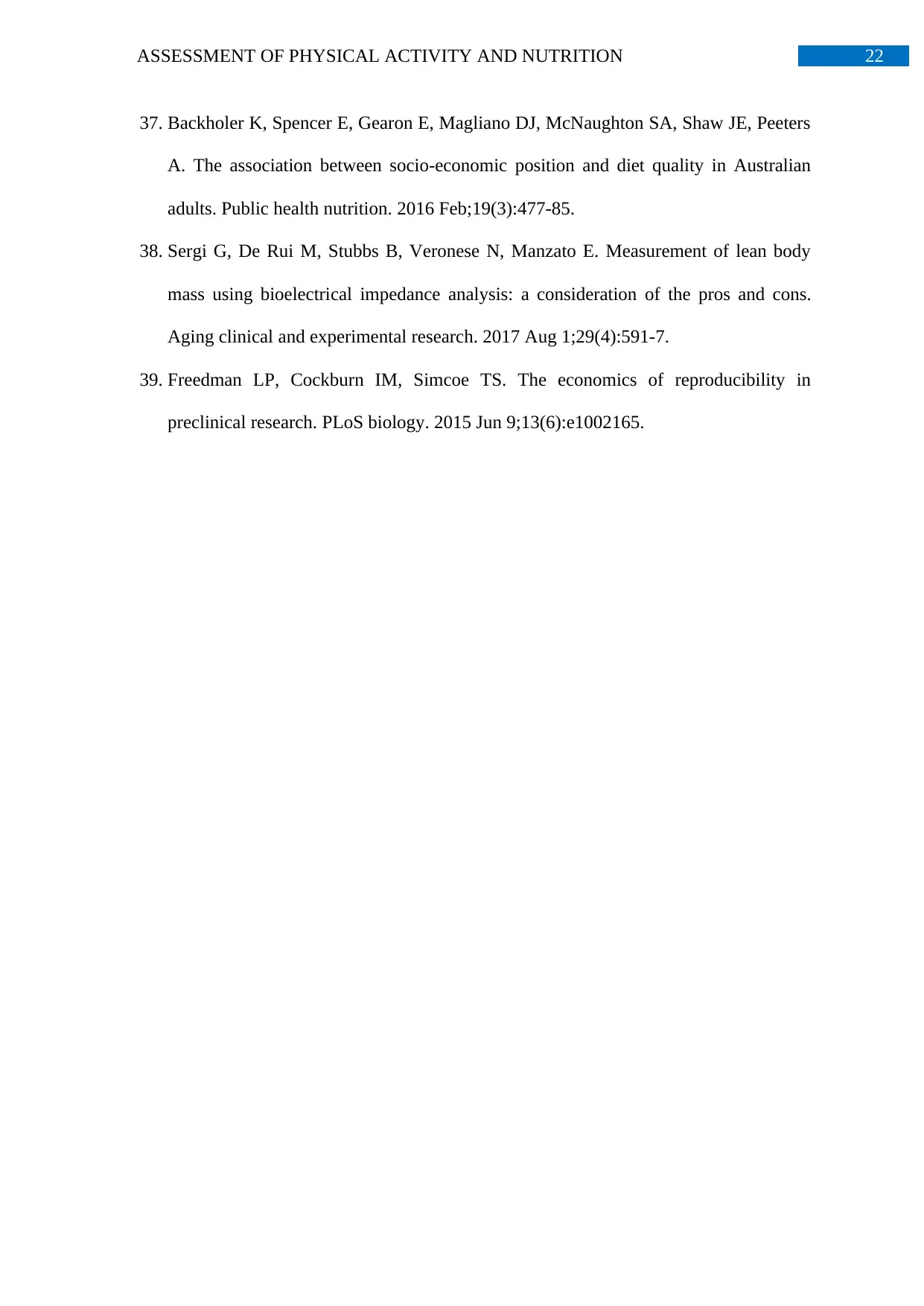
37. Backholer K, Spencer E, Gearon E, Magliano DJ, McNaughton SA, Shaw JE, Peeters
A. The association between socio-economic position and diet quality in Australian
adults. Public health nutrition. 2016 Feb;19(3):477-85.
38. Sergi G, De Rui M, Stubbs B, Veronese N, Manzato E. Measurement of lean body
mass using bioelectrical impedance analysis: a consideration of the pros and cons.
Aging clinical and experimental research. 2017 Aug 1;29(4):591-7.
39. Freedman LP, Cockburn IM, Simcoe TS. The economics of reproducibility in
preclinical research. PLoS biology. 2015 Jun 9;13(6):e1002165.
Related Documents
Your All-in-One AI-Powered Toolkit for Academic Success.
+13062052269
info@desklib.com
Available 24*7 on WhatsApp / Email
![[object Object]](/_next/static/media/star-bottom.7253800d.svg)
© 2024 | Zucol Services PVT LTD | All rights reserved.





